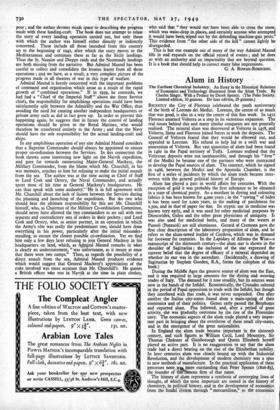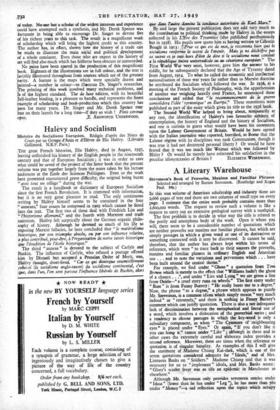Alum in History
The Earliest Chemical Industry. An Essay in the Historical Relations of Economics and Technology illustrated from the Alum Trade. By Charles Singer. With a Preface by Derek Spence. (The Folio Society. Limited edition, 10 guineas. De luxe edition, 25 guineas.) RECENTLY the City of Florence celebrated the 5ooth anniversary of the birth of Lorenzo dei Medici. Lorenzo, the centre of so much that was good, is also in a way the centre of this fine work. In 1472 Florence annexed Volterra as a step in its victorious expansion. The real issues behind this and many similar conquests are not generally realised. The mineral alum was discovered at Volterra in 1458, and Volterra, Siena and Florence joined forces to work the deposits. The Council of Volterra feared that they would be elbowed out, and appealed to Lorenzo. His refusal to help led to a swift war and annexation of Volterra. But vast quantities of alum had been found in 1461 in the Papal territory of Tolfa. Lorenzo realised that the Volterran deposits were not inexhaustible, and through his "firm" of the Medici he became one of the partners who were contracted to develop the Papal sources of alum. The contract, which he signed in 1466, between the Medici and the Apostolic Chamber, is the first of a series of incidents by which the alum trade became inter- woven with the general political history of Europe.
Alum has played a part in world affairs for centuries. With the exception of gold it was probably the first substance to be obtained in a state of chemical purity. As a mordant in dyeing and colouring fabrics it has been known for 4,000 years ; in the " tawing " of hides it has been used for 2,000 years, in the making of parchment for 1,500, and in that of paper for boo. Its styptic use in medicine was known very early, and it was used for other medicinal purposes by Dioscorides, Galen and the other great physicians of antiquity. It used also sed for medicinal baths, and many of the waters at Puteoli (Pozzuoli) are still aluminous. Gerard of Cremona gave the first clear description of the laboratory preparation of alum, and he refers to the alum-tawed leather of Cordova, which was in demand for footwear for centuries. In the Lapidary of Alfonso the Wise—a manuscript of the thirteenth century—the alum star is shown in the shoulder of Sagittarius ; the inclusion of the star expressed the current belief that the degree of efficacy of a mineral depended on whether its star was in the ascendant. (Incidentally, a drawing of Sagittarius by Stephen Gooden, R.A., forms the colophon of this book.) During the Middle Ages the greatest source of alum was the East, and it was required in large amounts for the dyeing and weaving trades of Italy. The demand for it rose steadily, but its sources were now in the hands of the Infidel. Economically, the Crusades ushered in the period of Papal opposition to trade with the Infidel, but though they interfered with that trade, it was never suspended. One after another the Italian city-states found alum a main-spring of their economics and of their politics. Genoa early passed the Bosphorus and exported alum. Pisa followed, and, after a period of great activity, she was gradually overcome by the rise of the Florentine navy. The economic aspects of the alum trade played a very impor- tant part in bringing about the overthrow of these small city-states, and in the emergence of the great nationalities.
In England the alum trade became important in the sixteenth century, and such figures as William Cecil, Lord Mountjoy, Sir Thomas Chaloner of Guisborough and Queen Elizabeth herself played an active part. It is no exaggeration to say that the alum trade had a direct bearing on the rise of the Elizabethan nobility. In later centuries alum was closely bound up with the Industrial Revolution, and the development of modem chemistry was a spur to new methods of manufacture. In the practical application of these processes none wik more outstanding than Peter Spence (1806-83), the founder of thous firm of that name.
The history of alum represents a synthesis of converging lines of thought, of which the most important are rooted in the history of chemistry, in political history, and in the development of economics from the feudal iystem through "mercantilism," to the economics of today. Nome but a scholar of the widest interests and experience could have attempted such a synthesis, and Mr. Derek Spence was fortunate in being able to encourage Dr. Singer to devote five of his richest years to this task. The result is a magnificent work of scholarship which will bring the highest credit to this country. The author has, in effect, shown how the history of a trade can be made to illustrate the main social and political development of a whole continent. Even those who are expert in the history of art will find also much which has hitherto been obscure or unrecorded.
No pains have been spared in the production of this magnificent book. Eighteen of the illustrations are in full colour, and the text is lavishly illustrated throughout from sources which are of the greatest :rarity. A feature is the maps which were specially drawn and tirinted—a number in colour—to illastrate Dr. Singer's researches. The printing of this work involved many technical problems, and Is of the highest standard. The de luxe edition, with its beautiful Tull-leather binding, is a pleasure to handle, and represents the finest example of scholarship and book-production which this country has Coen for many years. Dr. Singer and Mr. Derek Spence may rest on their laurels for a long time—if they so wish I Finis corona







































 Previous page
Previous page